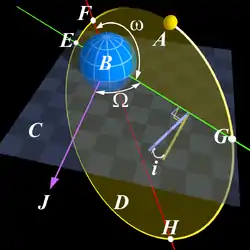Lissajous orbit
In orbital mechanics, a Lissajous orbit (pronounced [li.sa.ʒu]), named after Jules Antoine Lissajous, is a quasi-periodic orbital trajectory that an object can follow around a Lagrangian point of a three-body system with minimal propulsion. Lyapunov orbits around a Lagrangian point are curved paths that lie entirely in the plane of the two primary bodies. In contrast, Lissajous orbits include components in this plane and perpendicular to it, and follow a Lissajous curve. Halo orbits also include components perpendicular to the plane, but they are periodic, while Lissajous orbits are usually not.
| Part of a series on |
| Astrodynamics |
|---|
 |
In practice, any orbits around Lagrangian points L1, L2, or L3 are dynamically unstable, meaning small departures from equilibrium grow over time.[1] As a result, spacecraft in these Lagrangian point orbits must use their propulsion systems to perform orbital station-keeping. Although they are not perfectly stable, a modest effort of station keeping keeps a spacecraft in a desired Lissajous orbit for a long time.
In the absence of other influences, orbits about Lagrangian points L4 and L5 are dynamically stable so long as the ratio of the masses of the two main objects is greater than about 25.[2] The natural dynamics keep the spacecraft (or natural celestial body) in the vicinity of the Lagrangian point without use of a propulsion system, even when slightly perturbed from equilibrium.[3] These orbits can however be destabilized by other nearby massive objects. For example, orbits around the L4 and L5 points in the Earth–Moon system can last only a few million years instead of billions because of perturbations by the other planets in the Solar System.[4]
Spacecraft using Lissajous orbits
Several missions have used Lissajous orbits: ACE at Sun–Earth L1,[5] SOHO at Sun–Earth L1, DSCOVR at Sun–Earth L1,[6] WMAP at Sun–Earth L2,[7] and also the Genesis mission collecting solar particles at L1.[8] On 14 May 2009, the European Space Agency (ESA) launched into space the Herschel and Planck observatories, both of which use Lissajous orbits at Sun–Earth L2.[9]
ESA's Gaia mission also uses a Lissajous orbit at Sun–Earth L2.[10]
In 2011, NASA transferred two of its THEMIS spacecraft from Earth orbit to Lunar orbit by way of Earth–Moon L1 and L2 Lissajous orbits.[11]
In June 2018, Queqiao, the relay satellite for China's Chang'e 4 lunar lander mission, entered orbit around Earth-Moon L2.[12][lower-alpha 1]
Fictional appearances
In the 2005 science fiction novel Sunstorm by Arthur C. Clarke and Stephen Baxter, a huge shield is constructed in space to protect the Earth from a deadly solar storm. The shield is described to have been in a Lissajous orbit at L1. In the story a group of wealthy and powerful people shelter opposite the shield at L2 so as to be protected from the solar storm by the shield, the Earth and the Moon.
In the 2017 science fiction novel Artemis by Andy Weir, a Lissajous orbit is used as a transfer point for routine travel to and from the Moon.
See also
Notes
- Possibly a halo orbit. Sources disagree.
References
- "ESA Science & Technology: Orbit/Navigation". European Space Agency. 14 June 2009. Retrieved 2009-06-12.
- "A230242 – Decimal expansion of (25+3*sqrt(69))/2". OEIS. Retrieved 7 January 2019.
- Vallado, David A. (2007). Fundamentals of Astrodynamics and Applications (3rd ed.). Springer New York. ISBN 978-1-881883-14-2. (paperback), (hardback).
- Lissauer, Jack J.; Chambers, John E. (2008). "Solar and planetary destabilization of the Earth–Moon triangular Lagrangian points". Icarus. 195 (1): 16–27. Bibcode:2008Icar..195...16L. doi:10.1016/j.icarus.2007.12.024.
- "ACE Mission". izw1.caltech.edu. Retrieved 2023-08-03.
- Bergin, Chris (2015-02-11). "SpaceX Falcon 9 successfully launches the DSCOVR spacecraft". NASASpaceFlight.com. Retrieved 2023-08-03.
- "WMAP Observatory: Trajectory and Orbit". map.gsfc.nasa.gov. Retrieved 2023-08-03.
- "Genesis: Search for Origins | JPL | NASA". solarsystem.nasa.gov. Retrieved 2023-08-03.
- "Herschel: Orbit/Navigation". ESA. Retrieved 2006-05-15.
- "Gaia's Lissajous Type Orbit". ESA. Archived from the original on 2017-03-18. Retrieved 2006-05-15.
- ARTEMIS: The First Mission to the Lunar Libration Orbits
- Jones, Andrew (14 June 2018). "Chang'e-4 relay satellite enters halo orbit around Earth-Moon L2, microsatellite in lunar orbit". SpaceNews. Retrieved 6 January 2019.
External links
- Koon, W. S.; M. W. Lo; J. E. Marsden; S. D. Ross (2006). Dynamical Systems, the Three-Body Problem, and Space Mission Design. Archived (PDF) from the original on March 2, 2020.
- Koon, Wang Sang; et al. (2000). "Dynamical Systems, the Three-Body Problem, and Space Mission Design" (PDF). International Conference on Differential Equations. Berlin: World Scientific. pp. 1167–1181.

